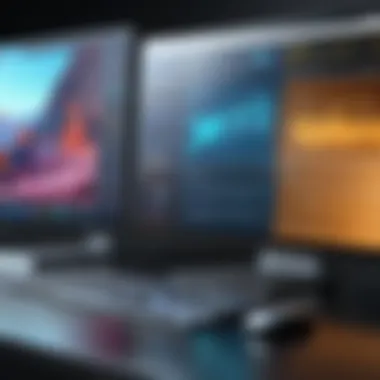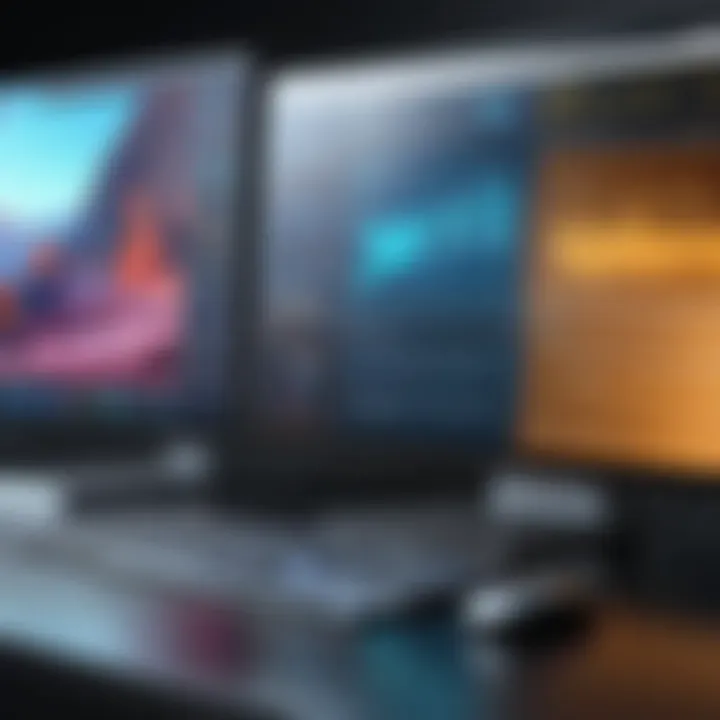Applications and Techniques of 3D Modeling Explained


Intro
3D modeling stands at the crossroads of creativity and technology, bridging real-world concepts with their digital counterparts. This powerful tool finds its relevance not just in artistic endeavors but also in serious business applications across industries like architecture, gaming, film, manufacturing, and even healthcare. The journey into the realm of 3D modeling is like peeling an onion; each layer reveals deeper complexities and opportunities that can profoundly reshape how professionals approach projects. As we embark on this exploration, it's essential to grasp not only the techniques and software available but also the underlying principles that govern this discipline.
In today’s landscape, where visual communication reigns supreme, the ability to create 3D models is increasingly valued. The versatility of 3D modeling allows for rapid prototyping, immersive simulations, and enhanced visualization, making it crucial for projects that demand precision and clarity.
Brief Description
Overview of the Software
Numerous software options exist for creating stunning 3D models, each offering unique sets of tools and capabilities. From Blender—an open-source powerhouse that has garnered a dedicated community—to Autodesk's Maya, famous in animation and visual effects, there's a tool suitable for every project.
Key players in the field include:
- SolidWorks: Tailored for engineering and design, especially in mechanical modeling.
- SketchUp: Renowned for its intuitive interface, ideal for architecture and interior design.
- Cinema 4D: Favored by motion graphics artists, bringing ease of use and impressive rendering capabilities.
- ZBrush: Known for its strength in sculpting, allowing artists to create intricate details often seen in character design.
Key Features and Functionalities
Each software provides functionalities bespoke to various user needs. Whether you're looking for high-resolution rendering or advanced animation tools, understanding these key features can guide your choice effectively.
- Real-time Rendering: Allows users to visualize their models instantly, making adjustments without long render times.
- Animation Tools: Essential for creators looking to bring their models to life, supporting both skeletal and object-based animation.
- Compatibility and Plug-ins: Many programs support third-party plug-ins, enhancing functionality and workflow.
System Requirements
To harness the full potential of 3D modeling software, meeting system requirements is imperative. Without the proper setup, users might face slow performance or even crashes during critical moments.
Hardware Requirements
For optimal performance in 3D modeling software, consider the following hardware aspects:
- Processor: At least a quad-core processor for faster processing of complex models.
- RAM: A minimum of 16GB is recommended, but 32GB or more can significantly enhance performance.
- Graphics Card: A good GPU like NVIDIA's RTX series is recommended for real-time rendering and high-resolution textures.
Software Compatibility
Most 3D modeling applications focus on compatibility with various operating systems. Thus, it's essential to ensure that your OS supports the software of choice. Most programs typically run on Windows or macOS, but some may also offer Linux versions.
"In the dynamic world of design, understanding the tools at your disposal is the cornerstone for innovation and growth in 3D modeling."
By delving deeper into the applications and techniques mentioned throughout this exploration, professionals can find guidance to navigate this intricate domain effectively, equipping themselves with not only the knowledge but also the tools that shape the future of design.
Prolusion to 3D Modeling
The world of 3D modeling unfolds itself as a pivotal tool across various fields, from entertainment to engineering. The importance of understanding this domain cannot be overstated. It serves not just to create realistic objects or characters on screen but also catalyzes innovative designs and efficient processes in multiple industries. 3D modeling allows professionals to visualize ideas and concepts before they come to fruition, saving both time and resources.
In the realm of design and production, the relevance of 3D modeling lies in its ability to bridge the gap between imagination and reality. It enables creators to simulate products and environments, providing a platform for experimentation without the physical constraints of traditional methods. For IT professionals and businesses alike, grasping the foundational aspects of 3D modeling opens up a treasure trove of opportunities for developing products and enhancing user experiences.
Whether it’s in creating immersive environments in gaming or designing sustainable architecture, its applications are vast and varied. This section lays the groundwork for understanding why diving deep into the world of 3D modeling is essential for anyone invested in technological advancement and design strategy.
Historical Background
The journey of 3D modeling is as fascinating as the technology itself. In the early days, efforts aimed at creating three-dimensional representations were rudimentary at best. The 1960s marked a significant turn with the advent of computer graphics, where pioneers like Ivan Sutherland introduced the first 3D graphics program, Sketchpad. At that time, it exemplified what researchers could envision about graphical systems.
Throughout the 1970s and 1980s, researchers developed more sophisticated algorithms and systems for rendering graphics, laying the foundation for more advanced modeling techniques. During these decades, tools began to emerge specifically designed for 3D modeling, allowing for more complex graphics and designs.
Fast forward to the early 21st century, many industries began harnessing these developments. The advent of advanced technologies, such as virtual reality and gaming engines, brought unprecedented changes to how 3D modeling was utilized in various sectors. 3D modeling is now an integral part of the production pipeline in animation studios, architectural firms, and manufacturing plants.


Definitions and Basics
So, what exactly is 3D modeling? At its core, 3D modeling is the mathematical representation of any three-dimensional object or shape. These digital representations can take various forms, from intricate sculpted figures to basic geometric shapes displayed on a computer screen. Understanding the basics of 3D modeling is fundamental to its application across industries.
- Geometric Representation: 3D models are composed of vertices, edges, and faces. These elements define the shape and structure of the object.
- Applications: They range from prototypes in manufacturing to visual effects in movies. The versatility of 3D modeling enhances creativity and innovation.
- Rendering and Animation: Once a model is completed, it can be rendered into 2D images or animated to show motion, adding another layer of depth to the experience.
3D modeling can appear daunting at first, but with the right techniques and software, anyone can start creating sophisticated models. The basics serve as a springboard into the myriad of techniques and applications that will be discussed in the subsequent sections.
Core Techniques in 3D Modeling
Understanding the core techniques in 3D modeling is central to grasping how this technology is applied across multiple fields. These techniques serve as the foundational building blocks for creating complex structures, characters, and environments in three-dimensional space. Companies, be they in gaming, architecture, or healthcare, depend on these methodologies to bring their visions into reality. As technology advances, knowing which techniques to employ—and how to employ them effectively—becomes ever more essential.
Polygonal Modeling
At the heart of 3D design lies polygonal modeling, a technique that leverages geometric shapes made up of vertices, edges, and faces to construct a model. This method is often favored for its versatility and the level of detail it allows. Artists can start with a simple shape, like a cube, and intricately refine it, manipulating individual vertices to create organic forms or intricate architectural features.
This technique shines in game design due to its compatibility with real-time rendering engines. For example, models created using polygonal techniques maintain a level of performance while delivering visual fidelity that players expect. The models can also be easily adjusted for lower resolutions, which is a must when optimizing for various platforms.
Overall, polygonal modeling is like piecing together a puzzle; it allows an artist to create a three-dimensional narrative layer by layer.
NURBS Modeling
NURBS, which stands for Non-Uniform Rational B-Splines, offers a different approach from polygonal modeling. Rather than creating a mesh of polygons, NURBS uses mathematical formulas to represent 3D geometry. This technique is especially useful in industries that require high precision and smooth surfaces, like automotive or aerospace design.
Imagine trying to model a sleek car body. Using NURBS allows designers to create graceful curves that are mathematically defined, ensuring that the surfaces are smooth and free from irregularities. This is especially important for manufacturing, where precision can mean the difference between a successful prototype and a costly error.
While NURBS is not as widely used in gaming, its significance in engineering and industrial design cannot be overstated. The adaptability and accuracy of this modeling technique make it indispensable in environments where dimensions are critical.
Sculpting Techniques
For those aiming to create highly detailed and intricate models, sculpting techniques resemble traditional clay modeling but in a digital format. This method allows artists to push, pull, and manipulate a model's surface in a way that's both natural and intuitive. It's commonly used in character design for films or animated features, where details like facial expressions and textures can be finely tuned.
With software like ZBrush or Mudbox, artists can combine multiple brushes and tools to achieve textures that can realistically mimic skin, cloth, or other materials. Some designers even prefer this method because it allows them to work organically—often adding detail on-the-fly without worrying about underlying structures, making it akin to sculpting from scratch.
For enthusiasts and professionals alike, it opens a direct path to creativity, presenting the opportunity to craft unique characters that go beyond conventional forms.
3D Scanning
Lastly, we have 3D scanning, a technique that allows one to capture real-world objects and render them into a digital format. This method employs various technologies, such as laser scanning or photogrammetry, to collect a cloud of points representing the object’s surface. From this data, a 3D model is constructed.
3D scanning has found its place not just in gaming or film but significantly in fields like cultural heritage preservation, where it aids in recording and restoring artifacts. By digitizing ancient sculptures or architecture, museums can share artifacts with a broader audience while minimizing wear and tear on the originals.
Moreover, in manufacturing, reverse engineering frequently uses 3D scanning to replicate parts of machines or devices, making it easier to create replacements or improvements efficiently. The practical applications are vast, underscoring the values of maintaining accuracy while working with complex shapes.
Overall, each technique contributes uniquely to the field of 3D modeling. Understanding their strengths and best-fit scenarios will empower professionals to select the appropriate tools for their projects, thus enhancing their creative output and technical capabilities.
Software Landscape for 3D Modeling
Understanding the software landscape for 3D modeling is crucial for anyone involved in this field. It is an environment that has rapidly evolved, giving rise to a diverse array of tools and options that cater to various application sectors. Whether one is an artist, engineer, or architect, knowing what software is available and how to leverage it can significantly enhance productivity and creativity. The right choice can also lead to more streamlined workflows and successful outcomes in projects.
Popular Software Tools
When exploring the realm of 3D modeling, several tools stand out prominently, and each has its own set of features tailored to specific needs. Here are some noteworthy examples:
- Autodesk Maya: Renowned for its robust features in animation and character rigging, it is widely used in the film and gaming industries.
- Blender: A versatile open-source platform, Blender offers a range of capabilities from modeling to animation, making it a top choice for both amateurs and professionals.
- 3ds Max: Frequently utilized in architectural visualization and gaming, this tool boasts powerful modeling and rendering options that lend themselves to realistic outputs.
- ZBrush: Ideal for artists focused on detailed sculpture work, ZBrush excels in creating intricate details that bring models to life.
In selecting software, users should keep in mind the type of projects they often work on and the specific features that would ease their tasks. For instance, if the goal is to create high-quality animations, Autodesk Maya might be a better fit than others.


Open Source vs. Proprietary Software
The choice between open source and proprietary software is significant. Open-source programs, like Blender, invite cost-effective experimentation, allowing users to test the waters without the financial commitment that proprietary options demand. Open-source tools also foster a community-driven approach, often leading to quick updates and a plethora of tutorials shared by users globally.
On the contrary, proprietary software usually comes with dedicated support, extensive documentation, and often a more polished interface. For example, Autodesk’s suite of tools, while pricey, provides resources that can rapidly bring individuals up to speed. Ultimately, the choice comes down to budget, project requirements, and personal preference regarding community support.
Choosing the Right Software
Selecting the right software isn't just about the price tag; it involves a thorough assessment of various factors:
- Project Type: Identify what you will primarily be working on. For architectural visualizations, tools like SketchUp or ArchiCAD can be more suitable.
- Skill Level: Newcomers might prefer user-friendly interfaces while seasoned professionals can navigate complex features.
- Collaborative Needs: Consider whether you’ll be working in teams. Some tools are built with collaboration in mind, facilitating easy sharing of work.
- Budget Constraints: Understand what you can afford. Balancing between cost and feature set is essential to find satisfactory software.
Determining the right fit is essential not only for immediate tasks but also for long-term projects that could grow in complexity.
"Choosing the right tool can streamline your workflow and open new avenues for creativity. It's not merely about function but finding a software that resonates with your style and needs."
As the field continues to grow and change, keeping abreast of updates and emerging tools is beneficial. New releases can introduce functionalities that might completely transform the way you approach your projects.
Applications of 3D Modeling in Various Industries
3D modeling has transformed how various industries operate, offering capabilities that go beyond traditional design methods. Its applications are vast, having established itself as a cornerstone in sectors from entertainment to healthcare. Each industry utilizes 3D modeling differently, leveraging its strengths for unique outcomes. Understanding these applications illuminates how modeling techniques drive innovation, improve efficiency, and foster creativity across landscapes.
Entertainment and Gaming
The entertainment industry, particularly gaming, has embraced 3D modeling as a core element of production. Just think about your favorite video game—each character and environment is crafted using intricate modeling techniques. Not only does this tech allow for the creation of visually stunning graphics, but it also supports the integration of complex animations and physics.
In game design, polygonal modeling is routinely used to create detailed characters, landscapes, and props. Game developers rely on software like Autodesk Maya and Blender to design realistic entities and immersive worlds. This high level of detail enhances user engagement, leading to richer gaming experiences. Furthermore, real-time rendering techniques have made it possible to see changes instantly, enabling developers to experiment creatively while staying on schedule .
Architecture and Construction
In architecture and construction, 3D modeling is more than just a design tool; it’s a means of communication among stakeholders. By creating 3D models, architects present their visions in a more tangible way. Not only can clients visualize what their buildings will look like, but engineers and construction teams can also pinpoint potential issues before the actual work begins.
BIM (Building Information Modeling) is a prime example of how 3D modeling is utilized in this sector. It allows for detailed planning and resource management, minimizing waste and saving time. The collaborative capabilities of BIM also empower teams to work more coherently, ensuring that everyone is on the same page. This level of coordination promotes more efficient project delivery, which is invaluable in a field where timelines and budgets are tight.
Healthcare and Medical Applications
In healthcare, 3D modeling plays a crucial role in improving patient outcomes. From creating custom prosthetics to simulating surgical procedures, its applications are life-changing. Surgeons, for example, use 3D models derived from patient scans to plan complex operations, increasing their precision and success rates.
Moreover, in medical training, 3D models of anatomy provide invaluable resources for students and professionals alike. Instead of relying solely on textbooks, trainees can interact with lifelike representations, enhancing their understanding of human anatomy. This hands-on experience not only boosts their confidence but also prepares them better for real-world scenarios.
Manufacturing and Prototyping
In the realm of manufacturing, 3D modeling is pivotal for prototyping and product development. Designers can create virtual prototypes, allowing for immediate feedback and revisions before moving to the production phase. This iterative process significantly cuts down lead times and costs associated with traditional prototyping.
Additive manufacturing, commonly known as 3D printing, has revolutionized production methods as well. This tech enables businesses to produce parts on demand, reducing the need for extensive inventory. Companies like Stratasys, for example, highlight the advantages of this approach by offering solutions that cater to specific manufacturing needs across different sectors.
"3D modeling is not just about creating images; it’s about crafting experiences, solutions, and innovations that shape our world."
In summary, the applications of 3D modeling are far-reaching, impacting various industries with its versatility and efficiency. The constant evolution of technology in tandem with creativity ensures that 3D modeling continues to foster new possibilities, enhancing processes and ultimately contributing to better outcomes.
Challenges in 3D Modeling
The world of 3D modeling, while brimming with potential and creativity, isn’t without its share of challenges. These hurdles can hinder both novice users and seasoned professionals in their quest to produce visually stunning and operational models. Understanding these challenges can shed light on the intricacies of 3D modeling and control the impact on project timelines, costs, and quality of outputs. By confronting these obstacles head-on, professionals can better strategize their approach and enhance their workflows.
Technical Limitations
When it comes to 3D modeling, technical limitations can manifest in various forms. For instance, the capability of the hardware used plays a crucial role; outdated CPUs or insufficient RAM can lead to sluggish performance. Particularly in applications where real-time rendering is necessary, like gaming or virtual reality, the demand for high-performance machines is evident.


Moreover, modeling intricate geometries can become nearly impossible on lower-tier software applications, resulting in compromised designs. Thus, understanding the specifications of one’s hardware, as well as the limitations of one's chosen software, is vital in achieving the desired modeling outcome.
"Technical limitations can stunt creativity; knowing your tools is as important as knowing your craft."
Resource Management
Efficient resource management in 3D modeling projects is of utmost importance. Whether it’s time, talent, or technology, resources must be allocated wisely. Often, projects can spiral out of control when deadlines loom. This is particularly challenging when teams comprise individuals with varying skill sets. If the right resources — both human and technical — are not in place, it can lead to delays and budget overruns.
For instance, it may turn out that a particular project requires complex modeling techniques that only a few team members are trained in. Thus, investing in training or hiring specialists could become necessary, but this must be balanced against project timelines and costs. Striking this balance ensures the team works efficiently while maintaining high-quality outputs.
Learning Curve for New Users
The learning curve for new users in the realm of 3D modeling can be quite steep, often leading to frustration. For those unfamiliar with the various software tools and techniques, jumping into complex tasks can feel like diving into the deep end of the pool without knowing how to swim.
New users must wrestle with not only conceptualizing their designs but also mastering the intricacies of the software. Tutorials, online forums, and courses can help mitigate this challenge, but significant time and effort must be invested. Some software may be more user-friendly than others, but ultimately, every tool has its own set of commands and workflows that demand time and practice.
The Future of 3D Modeling
As technology continues to evolve at a breakneck speed, the future of 3D modeling looks more promising than ever. This aspect is not just about rendering pretty pictures; it's about redefining how we design, build, and interact with the world around us. Three-dimensional modeling is fast becoming the backbone of numerous fields, facilitating innovation and driving efficiencies that were previously unimaginable. To understand the trajectory of this discipline, we must pay close attention to the emerging trends, the integration with virtual and augmented reality, and the sustainability and ethical considerations that might shape this domain for years to come.
Emerging Trends
The landscape of 3D modeling is undergoing seismic shifts, driven by advancements in technology and changing user needs. Here are some notable trends worth keeping an eye on:
- AI and Machine Learning: The infusion of artificial intelligence promises to streamline creation processes and enable automatic modeling. This could mean fewer repetitive tasks and more time for creativity.
- Cloud-Based Solutions: The rise of cloud computing allows teams to collaborate on 3D projects in real time, regardless of their geographical location. This fosters a more fluid exchange of ideas and accelerates project completion.
- Real-Time Rendering: Technologies that offer real-time rendering enable designers to see changes instantaneously, allowing for rapid iteration and refinement.
"Real-time rendering isn't just a luxury anymore; it's becoming a necessity in industries like gaming and architecture, where visual feedback can significantly impact decision-making."
Keeping up with these trends is vital for professionals looking to remain at the forefront of the 3D modeling field, providing them with the tools to innovate.
Integration with Virtual and Augmented Reality
The intersection of 3D modeling with virtual reality (VR) and augmented reality (AR) is another area of profound impact. As these technologies mature, they offer functions previously thought to be merely speculative. For example:
- Enhanced User Experiences: In industries like real estate, potential buyers can walk through properties in a virtual space, giving them a more immersive experience. This not only aids in the selling process but also allows architects to visualize their designs in a lifelike context.
- Training and Simulation: In healthcare, for instance, VR can provide lifelike simulations for training purposes, allowing medical professionals to practice procedures in a safe environment. It bridges the gap between theory and practice.
This confluence of VR, AR, and 3D modeling does not merely enrich user interaction; it revolutionizes how industries perceive design and implementation.
Sustainability and Ethical Considerations
As with any technological advancement, the future of 3D modeling brings forth a host of ethical and environmental considerations. Addressing these issues is paramount to ensure the industry evolves responsibly:
- Resource Management: With the potential to create prototypes faster and at lower costs, businesses must reflect on how this impacts materials used and waste generated. Sustainable practices should start from the modeling stage.
- Ethical Use of Imagery: With 3D modeling technologies advancing into realms like deep fake media, transparency in how these technologies are employed becomes critical. Establishing clear guidelines and ethical frameworks is necessary to prevent misuse.
Maintaining a focus on sustainability and ethical practices not only enhances the credibility of the industry but also ensures that the innovations cater to today's pressing global challenges into the future.
The End
As we bring our exploration of 3D modeling to a close, it's crucial to reflect on the myriad intersections this technology has with various fields. The importance of this topic extends beyond mere technical proficiency; it highlights the transformative potential of 3D modeling in shaping industries and driving innovation.
Summary of Key Points
In summary, we have traversed the core techniques that form the backbone of 3D modeling, from polygonal modeling to more complex sculpting and scanning methods. Each technique offers unique advantages tailored to different applications. We’ve also examined the extensive software landscape, weighing the merits of popular tools against open-source alternatives, allowing users to make informed choices that fit their specific needs. Additionally, it’s clear that 3D modeling's applications span a wide array of sectors:
- Entertainment and Gaming: Where imagination meets reality, bringing characters and worlds to life.
- Architecture and Construction: Enhancing visualization and design precision.
- Healthcare: Facilitating advanced medical imaging and personalized treatments.
- Manufacturing: Revolutionizing prototyping and accelerating product development.
Each sector demonstrates the immense value and versatility of 3D modeling, reminding us that innovation is only a few clicks away.
Final Thoughts on Innovation in 3D Modeling
Looking to the future, the role of 3D modeling will only grow, especially as we delve deeper into realms like virtual and augmented reality. The capabilities for immersive experiences and design exploration are seemingly limitless. However, we must also tread carefully, considering sustainability and ethical implications. As businesses and creators harness these tools, understanding the impact on both the environment and society becomes paramount. In doing so, we pave the way for responsible innovation, ensuring that 3D modeling benefits not just industries, but the very communities they aim to serve.
Innovation in 3D modeling isn't just about the tools, it's about the vision they help bring to life.



